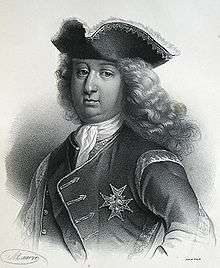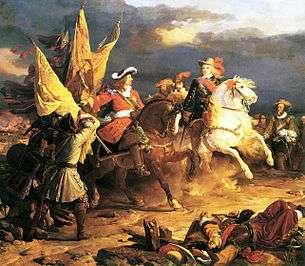Louis Joseph, Duke of Vendôme
| Louis Joseph | |||||
|---|---|---|---|---|---|
| Duke of Vendôme | |||||
 Louis Joseph on campaign, 1706. | |||||
| Duke of Vendôme | |||||
| Reign | 12 August 1669 – 11 June 1712 | ||||
| Predecessor | Louis | ||||
| Successor | Philippe | ||||
| Born |
1 July 1654 Paris, France | ||||
| Died |
11 June 1712 (aged 57) Vinaròs, Spain | ||||
| Burial | El Escorial, Spain | ||||
| Spouse | Marie Anne de Bourbon | ||||
| |||||
| Father | Louis de Bourbon | ||||
| Mother | Laura Mancini | ||||
| Religion | Roman Catholicism | ||||
| Signature |
| ||||
Louis Joseph de Bourbon, Duke of Vendôme (Louis Joseph; 1 July 1654 – 11 June 1712) was a French military commander during the War of the Grand Alliance and War of the Spanish Succession, Marshal of France.
Biography

He was the son of Louis de Bourbon, and the illegitimate great-grandson of Henry IV of France and his mistress, Gabrielle d'Estrées. He was born in Paris. His mother was Laura Mancini, the elder sister of Olympia Mancini, the mother of Prince Eugene of Savoy, his future opponent.
Orphaned at the age of fifteen, he inherited a vast fortune from his father that had been handed down from his great-grand mother, the duchesse de Mercœur et Penthièvre in her own right. Prior to succeeding his father in 1669, he was known as the duc de Penthièvre. He was raised by his aunt, Marie Anne Mancini, duchesse de Bouillon.
Entering the army at the age of eighteen, he soon distinguished himself by his vigour and personal courage in the Dutch wars, and by 1688 he had risen to the rank of lieutenant-general. In the Nine Years' War he rendered conspicuous service under the duc de Luxembourg at the Battle of Steenkerke and under Nicolas Catinat at Marsaglia. In 1695, he was placed in command of the army operating in Catalonia where he took Barcelona in 1697.[1]
Soon afterwards, he was made a maréchal. In 1702, after the first unsuccessful campaign of Catinat and Villeroi, he was placed in command of the Franco-Spanish army in Italy. During three campaigns in that country he proved himself a worthy antagonist to Prince Eugène of Savoy, whom he at last defeated in 1705 at Cassano in a magnificent show of courage and command over his troops, converting the impending defeat that his indolent brother, Philippe, the Grand Prior, had incurred, into a glorious success.[1]
The next year, after holding his own as before, and gaining another victory at Calcinato, he was sent to Flanders to repair the disaster of Ramillies.[1] Following the departure of Vendôme to shore up the shattered army in the Flanders, Prince Eugène and the Duke of Savoy inflicted a heavy loss on the French under the duc d'Orléans and Ferdinand de Marsin at the Battle of Turin, driving the French out of Italy by the end of the year. In Flanders, meanwhile, Vendôme quarrelled with the king's unenterprising grandson, the duc de Bourgogne, and was unable to prevent the French defeat at the Battle of Oudenarde.
In disgust, Vendôme retired to his estates. It wasn't long, however, before he was summoned back to take command of the army of his cousin, Philip, in Spain. There he won his last victories, crowning his work triumphantly in the battles of Brihuega and Villaviciosa. Before the end of the war, he died suddenly at Vinaròs on 11 June 1712[1] and was buried in El Escorial in Spain.
Vendôme was one of the most remarkable soldiers in the history of the French army. He had, besides the skill and the fertile imagination of the true army leader, the brilliant courage of a soldier. The real secret of his continuous success, however, was his extraordinary influence over his men.[1]
Marriage
He married Marie Anne de Bourbon (1678–1718), a daughter of Henri Jules, Prince of Condé and granddaughter of Le Grand Condé.
Reputedly very ugly, her father died leaving her unmarried. Her brother, who became the Prince of Condé in 1709, died the next year not having helped his sister marry. She could have married the duc du Maine in 1692, but Maine preferred Marie Anne's sister, Anne Louise Bénédicte de Bourbon, and married her instead.
The marriage ceremony occurred at the chapel at the Château de Sceaux on 21 May 1710. Sceaux was the residence of Anne Louise Bénédicte. Louis Joseph was fifty-five years old at the time. He was a Marshal of France and had been designated as the heir of his cousin, King Philip V of Spain . In the event that Philip should die childless, the House of Bourbon had decided that Louis Joseph would become the next king of Spain. The marriage remained childless though. This may have been due to the homosexual tendencies of her husband.[2] Vendôme had been a lover of Marie Anne's own brother-in-law, the Prince of Conti, husband of her oldest sister, Marie Thérèse de Bourbon. As it turned out, Marie Anne died in 1718 without any children.
Although Louis XIV had given permission for the marriage, the manipulative duc and duchesse du Maine hurriedly arranged the details of the wedding, probably for mercenary reasons. Even though the Dowager Princess of Condé was not informed of the marriage, she was present at the bedding ceremony at Sceaux along with Louis Henri, Duke of Bourbon; his wife Marie Anne de Bourbon;[3] the Dowager Princess of Conti and her children the Prince of Conti and Mademoiselle de La Roche-sur-Yon.
On his death, Louis Joseph left his wife the Duchy of Étampes and its lands. She held this title in her own right. When she died, it went to her niece, the Princess of Conti.
Ancestry
| Ancestors of Louis Joseph, Duke of Vendôme | ||||||||||||||||||||||||||||||||||||||||||||||||||||||||||||||||||||||||||||||||||||||||||||||||||||||||||||||||||||||||||||||||||||||||||||||||||||||||||||||||||||||||||||||||||||||||||||||||||||||||||||||||||||||||||||||||||||||||||||||||||||||||||||||||||||||||||||||||||||||||||||||||||||||||||||||||||||||||||||||||||||||||||||||||||||||||||||||||||||||||||||||||||||||||||||||||||||||||||||||||||||||||||||||||||||||||||||||||||||||||||||||||||||||||||||||||||||||||||||||||||||||||||||||||||||||||||||||||||
|---|---|---|---|---|---|---|---|---|---|---|---|---|---|---|---|---|---|---|---|---|---|---|---|---|---|---|---|---|---|---|---|---|---|---|---|---|---|---|---|---|---|---|---|---|---|---|---|---|---|---|---|---|---|---|---|---|---|---|---|---|---|---|---|---|---|---|---|---|---|---|---|---|---|---|---|---|---|---|---|---|---|---|---|---|---|---|---|---|---|---|---|---|---|---|---|---|---|---|---|---|---|---|---|---|---|---|---|---|---|---|---|---|---|---|---|---|---|---|---|---|---|---|---|---|---|---|---|---|---|---|---|---|---|---|---|---|---|---|---|---|---|---|---|---|---|---|---|---|---|---|---|---|---|---|---|---|---|---|---|---|---|---|---|---|---|---|---|---|---|---|---|---|---|---|---|---|---|---|---|---|---|---|---|---|---|---|---|---|---|---|---|---|---|---|---|---|---|---|---|---|---|---|---|---|---|---|---|---|---|---|---|---|---|---|---|---|---|---|---|---|---|---|---|---|---|---|---|---|---|---|---|---|---|---|---|---|---|---|---|---|---|---|---|---|---|---|---|---|---|---|---|---|---|---|---|---|---|---|---|---|---|---|---|---|---|---|---|---|---|---|---|---|---|---|---|---|---|---|---|---|---|---|---|---|---|---|---|---|---|---|---|---|---|---|---|---|---|---|---|---|---|---|---|---|---|---|---|---|---|---|---|---|---|---|---|---|---|---|---|---|---|---|---|---|---|---|---|---|---|---|---|---|---|---|---|---|---|---|---|---|---|---|---|---|---|---|---|---|---|---|---|---|---|---|---|---|---|---|---|---|---|---|---|---|---|---|---|---|---|---|---|---|---|---|---|---|---|---|---|---|---|---|---|---|---|---|---|---|---|---|---|---|---|---|---|---|---|---|---|---|---|---|---|---|---|---|---|---|---|---|---|---|---|---|---|---|---|---|---|---|---|---|---|---|---|---|---|---|---|---|---|---|---|---|---|---|---|---|---|---|---|---|---|---|---|---|---|---|---|---|---|---|---|---|---|---|---|---|---|---|---|---|---|---|---|---|---|---|---|---|---|---|---|---|---|---|---|---|---|---|---|---|---|---|---|---|---|---|---|---|---|---|---|---|---|---|---|---|---|---|---|---|---|---|---|---|---|---|---|---|---|---|---|---|
| ||||||||||||||||||||||||||||||||||||||||||||||||||||||||||||||||||||||||||||||||||||||||||||||||||||||||||||||||||||||||||||||||||||||||||||||||||||||||||||||||||||||||||||||||||||||||||||||||||||||||||||||||||||||||||||||||||||||||||||||||||||||||||||||||||||||||||||||||||||||||||||||||||||||||||||||||||||||||||||||||||||||||||||||||||||||||||||||||||||||||||||||||||||||||||||||||||||||||||||||||||||||||||||||||||||||||||||||||||||||||||||||||||||||||||||||||||||||||||||||||||||||||||||||||||||||||||||||||||
References
- 1 2 3 4 5
 One or more of the preceding sentences incorporates text from a publication now in the public domain: Chisholm, Hugh, ed. (1911). "Vendôme, Louis Joseph, Duc de". Encyclopædia Britannica. 27 (11th ed.). Cambridge University Press. p. 982.
One or more of the preceding sentences incorporates text from a publication now in the public domain: Chisholm, Hugh, ed. (1911). "Vendôme, Louis Joseph, Duc de". Encyclopædia Britannica. 27 (11th ed.). Cambridge University Press. p. 982. - ↑ Aldrich, Robert (2003). Who's Who in Gay and Lesbian History. Psychology Press. p. 542.
- ↑ niece of Marie Anne as daughter of Marie Thérèse de Bourbon, Dowager Princess of Conti
![]() This article incorporates text from a publication now in the public domain: Gilman, D. C.; Thurston, H. T.; Colby, F. M., eds. (1905). "article name needed". New International Encyclopedia (1st ed.). New York: Dodd, Mead.
This article incorporates text from a publication now in the public domain: Gilman, D. C.; Thurston, H. T.; Colby, F. M., eds. (1905). "article name needed". New International Encyclopedia (1st ed.). New York: Dodd, Mead.
Publications
- De Bellerive, Les dernières campagnes de Louis Joseph de Vendôme (Paris, 1714)
- Voltaire, Le siècle de Louis XIV
